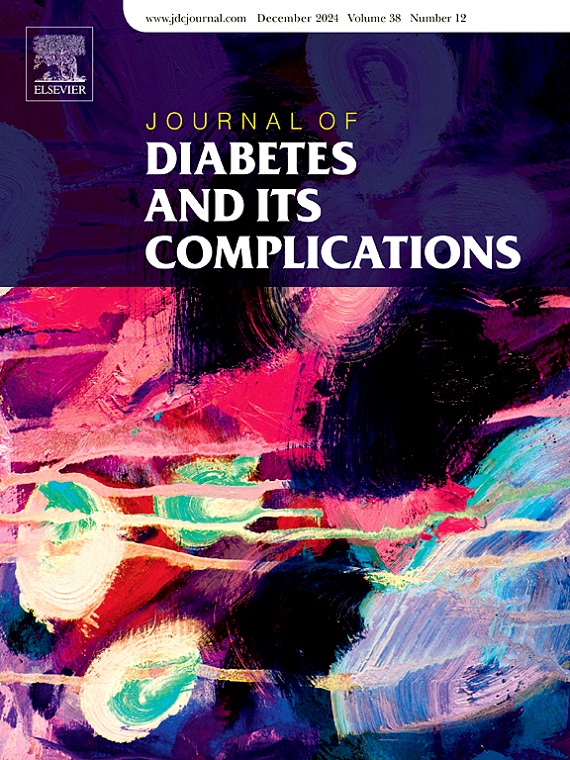妊娠期糖尿病和随后的慢性肾脏疾病风险:一项系统回顾和荟萃分析。
IF 3.1
3区 医学
Q3 ENDOCRINOLOGY & METABOLISM
引用次数: 0
摘要
目的:关于妊娠期糖尿病(GDM)与以后生活中慢性肾脏疾病(CKD)风险之间关系的证据一直不一致。我们系统地评估了这种关联是否存在。方法:我们检索了PubMed、Embase和Cochrane图书馆数据库,从它们建立到2025年5月18日。计算优势比(ORs)和95%置信区间(ci)来评估GDM和随后的CKD之间的关系。结果:我们的meta分析纳入了8篇涉及21,806,683名孕妇的文章。GDM组发生CKD的总风险显著高于对照组(OR = 1.79, 95% CI = 1.16-2.78, P = 0.009)。进一步的分析仅限于高质量研究(OR = 2.75, 95% CI = 1.68-4.52, P 2 = 96.8%)或调整了关键混杂因素的研究(OR = 2.76, 95% CI = 1.67-4.52, P = 0.001, I2 = 65.9%)也显示了显著的相关性。大多数亚组分析结果与总体结果一致。结论:本系统综述和荟萃分析支持GDM与未来CKD风险之间的显著关联,提示GDM可能作为肾脏疾病的早期预警信号。然而,对结果的信心由于相当大的异质性而降低,需要更多的工作来理解这种可变性。本文章由计算机程序翻译,如有差异,请以英文原文为准。
Gestational diabetes mellitus and the subsequent risk of chronic kidney disease: A systematic review and meta-analysis
Aims
The evidence regarding a relationship between gestational diabetes mellitus (GDM) and the risk of chronic kidney disease (CKD) in later life has been inconsistent. We systematically evaluated whether such an association exists.
Methods
We searched the PubMed, Embase, and Cochrane Library databases from their inception to 18 May 2025. Odds ratios (ORs) and 95 % confidence intervals (CIs) were calculated to assess the association between GDM and subsequent CKD.
Results
Eight articles involving 21,806,683 pregnant women were included in our meta-analysis. The overall risk of CKD in the GDM group was significantly higher than in the control group (OR = 1.79, 95 % CI = 1.16–2.78, P = 0.009). Further analyses restricted to high-quality studies (OR = 2.75, 95 % CI = 1.68–4.52, P < 0.01, I2 = 96.8 %) or to studies adjusting for key confounders (OR = 2.76, 95 % CI = 1.67–4.52, P = 0.001, I2 = 65.9 %) also demonstrated a significant association. Most subgroup analysis results were consistent with the overall findings.
Conclusions
This systematic review and meta-analysis support a significant association between GDM and future CKD risk, suggesting that GDM may serve as an early warning sign for renal disease. However, confidence in the results was reduced by the considerable heterogeneity and more work is needed to understand this variability.
求助全文
通过发布文献求助,成功后即可免费获取论文全文。
去求助
来源期刊

Journal of diabetes and its complications
医学-内分泌学与代谢
CiteScore
5.90
自引率
3.30%
发文量
153
审稿时长
16 days
期刊介绍:
Journal of Diabetes and Its Complications (JDC) is a journal for health care practitioners and researchers, that publishes original research about the pathogenesis, diagnosis and management of diabetes mellitus and its complications. JDC also publishes articles on physiological and molecular aspects of glucose homeostasis.
The primary purpose of JDC is to act as a source of information usable by diabetes practitioners and researchers to increase their knowledge about mechanisms of diabetes and complications development, and promote better management of people with diabetes who are at risk for those complications.
Manuscripts submitted to JDC can report any aspect of basic, translational or clinical research as well as epidemiology. Topics can range broadly from early prediabetes to late-stage complicated diabetes. Topics relevant to basic/translational reports include pancreatic islet dysfunction and insulin resistance, altered adipose tissue function in diabetes, altered neuronal control of glucose homeostasis and mechanisms of drug action. Topics relevant to diabetic complications include diabetic retinopathy, neuropathy and nephropathy; peripheral vascular disease and coronary heart disease; gastrointestinal disorders, renal failure and impotence; and hypertension and hyperlipidemia.
 求助内容:
求助内容: 应助结果提醒方式:
应助结果提醒方式:


